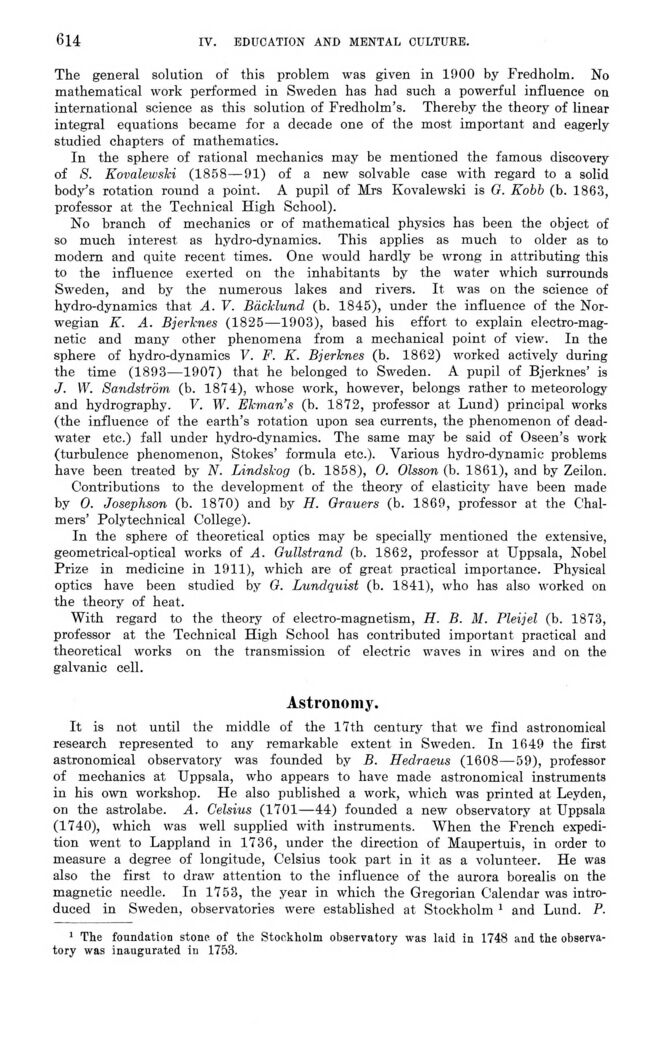
Full resolution (JPEG) - On this page / på denna sida - IV. Education and Mental Culture. Introd. by P. E. Lindström - 11. Science - Mechanics and Mathematical Physics. By C. W. Oseen - Astronomy. By Karl Bohlin

<< prev. page << föreg. sida << >> nästa sida >> next page >>
Below is the raw OCR text
from the above scanned image.
Do you see an error? Proofread the page now!
Här nedan syns maskintolkade texten från faksimilbilden ovan.
Ser du något fel? Korrekturläs sidan nu!
This page has never been proofread. / Denna sida har aldrig korrekturlästs.
’614
iv. education and mental culture.
The general solution of this problem was given in 1900 by Fredholm. No
mathematical work performed in Sweden has had such a powerful influence on
international science as this solution of Fredholm’s. Thereby the theory of linear
integral equations became for a decade one of the most important and eagerly
studied chapters of mathematics.
In the sphere of rational mechanics may be mentioned the famous discovery
of 8. Kovalewslci (1858—91) of a new solvable case with regard to a solid
body’s rotation round a point. A pupil of Mrs Kovalewski is G. Kobb (b. 1863,
professor at the Technical High School).
No branch of mechanics or of mathematical physics has been the object of
so much interest as hydro-dynamics. This applies as much to older as to
modern and quite recent times. One would hardly be wrong in attributing this
to the influence exerted on the inhabitants by the water which surrounds
Sweden, and by the numerous lakes and rivers. It was on the science of
hydro-dynamics that A. V. Backlund (b. 1845), under the influence of the
Norwegian K. A. Bjerknes (1825—1903), based his effort to explain
electro-magnetic and many other phenomena from a mechanical point of view. In the
sphere of hydro-dynamics V. F. K. Bjerknes (b. 1862) worked actively during
the time (1893—1907) that he belonged to Sweden. A pupil of Bjerknes’ is
J. W. Sandström (b. 1874), whose work, however, belongs rather to meteorology
and hydrography. V. W. Ekman’s (b. 1872, professor at Lund) principal works
(the influence of the earth’s rotation upon sea currents, the phenomenon of
dead-water etc.) fall under hydro-dynamics. The same may be said of Oseen’s work
(turbulence phenomenon, Stokes’ formula etc.). Various hydro-dynamic problems
have been treated by N. Lindskog (b. 1858), O. Olsson (b. 1861), and by Zeilon.
Contributions to the development of the theory of elasticity have been made
by O. Josephson (b. 1870) and by H. Grauers (b. 1869, professor at the
Chalmers’ Polytechnical College).
In the sphere of theoretical optics may be specially mentioned the extensive,
geometrical-optical works of A. Gullstrand (b. 1862, professor at Uppsala, Nobel
Prize in medicine in 1911), which are of great practical importance. Physical
optics have been studied by G. Lundquist (b. 1841), who has also worked on
the theory of heat.
With regard to the theory of electro-magnetism, H. B. M. Pleijel (b. 1873,
professor at the Technical High School has contributed important practical and
theoretical works on the transmission of electric waves in wires and on the
galvanic cell.
Astronomy.
It is not until the middle of the 17th century that we find astronomical
research represented to any remarkable extent in Sweden. In 1649 the first
astronomical observatory was founded by B. Hedraeus (1608—59), professor
of mechanics at Uppsala, who appears to have made astronomical instruments
in his own workshop. He also published a work, which was printed at Leyden,
on the astrolabe. A. Celsius (1701—44) founded a new observatory at Uppsala
(1740), which was well supplied with instruments. When the French
expedition went to Lappland in 1736, under the direction of Maupertuis, in order to
measure a degree of longitude, Celsius took part in it as a volunteer. He was
also the first to draw attention to the influence of the aurora borealis on the
magnetic needle. In 1753, the year in which the Gregorian Calendar was
introduced in Sweden, observatories were established at Stockholm 1 and Lund. P.
1 The foundation stone of the Stockholm observatory was laid in 1748 and the
observatory was inaugurated in 1753.
<< prev. page << föreg. sida << >> nästa sida >> next page >>